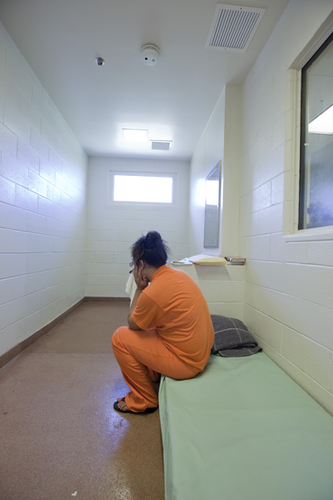Prison is a bad place for children. Solitary confinement is worse yet. Extended solitary confinement is lethal. These are not surprising statements, and the news that underwrites them, though dismaying, is not particularly shocking.
Immigration detention centers in the US, such as the Eloy Detention Center in Arizona, run by Corrections Corporation of America, or the Reeves County Detention Center, run by GEO, are lethal, fatal black holes for all residents. Joe Arpaio’s jail in Maricopa County is only the best known example of humiliation and terror against all Latinas and Latinos, irrespective of status, and which results in increased anxiety and mental health problems for Latina and Latino children.
And it is estimated that more than 60 of those held in Guantanamo were under 18 when they were arrested and sent to Cuba.
In England, Yarl’s Wood Immigration Removal Centre is so terrible for children that the entire nation is now considered unsafe for children of immigrant parents, including those seeking asylum and refuge. The place literally drives children mad.
Juvenile centers in the United States report that sexual abuse of prisoners, by other prisoners and, more, by staff, is off the charts. In 2008 – 2009, in more than a few juvenile detention centers, a recent study suggested that nearly one out of every three prisoners suffered some sort of sexual abuse.
When children go to prison, how are they educated? According to some, they’re not at all. California is being sued in a federal class action case for failing to educate youth in their `probation camps.’
These are terrible and tragic and all too familiar. Prison is a bad place, after all. Bad things happen.
Those bad things that happen to children are not restricted to prisons. Take “seclusion rooms”, for example: “Seclusion is the involuntary confinement of a student alone in a room or area from which the student is physically prevented from leaving. This includes situations where a door is locked as well as where the door is blocked by other objects or held by staff.”
This happens in schools all over the United States.
In the state of Georgia, public schools have “seclusion rooms,” solitary confinement cells. The doors are double bolted on the outside: “Seclusion rooms are allowed in Georgia public schools provided they are big enough for children to lie down, have good visibility and have locks that spring open in case of an emergency such as a fire. In 2004, Jonathan King, 13, hanged himself in one such room, a stark, 8-foot-by-8-foot “timeout” room in a Gainesville public school.” Time out. When schools put children into solitary confinement, what time is left?
What is left for Jonathan King’s parents, so many years later? Pain, anguish. Only now is Georgia finally responding by considering a law that protects all students from seclusion and restraint. It only took the State legislature six years … equal to almost half of Jonathan King’s entire life.
In May 2009, the Missouri state legislature passed a law giving the school districts two years in which to devise written policies governing the use of seclusion rooms. Before that, there were no policies, only the practice of solitary confinement of school children without a single written guideline or rule. This is now an issue in the upcoming GOP primary for State Senate. One candidate sees restrictions on solitary confinement of children as a violation of local sovereignty.
Florida state legislators are also considering a bill to restrict the use of restraint and seclusion. There are seclusion rooms all over the state school system, from elementary on up. Up til now, there has been no written policy.
Not surprisingly, solitary confinement is of particular concern to parents of children living with disabilities. Here are two stories from Florida:
When a twelve year old girl with autism repeated names of movies, shoved papers off her desk or waved her arms and kicked her legs toward approaching teachers, they responded by grabbing the eighty pound girl, forcing her to the ground and holding her there. This happened forty-four times during the 2006-07 school year. She was held once for an hour, and, on average, twenty-two minutes at a time. At least one incident left her back badly bruised.
When a seven year old girl, diagnosed with autism and bipolar disorder had her head pushed to the floor, the parents discovered several other frequent inappropriate uses of restraint and seclusion. The county where they live leaves it to individual schools to write their own policies on restraint or seclusion use.
These come from a 2009 report issued by the National Disability Rights Network: School is not supposed to hurt: Investigative Report on Abusive Restraint and Seclusion in Schools. The stories come from all over the United States.
On the cover is the picture of a lovely, smiling seven year-old girl, from Wisconsin:
A seven year old girl was suffocated and killed at a mental health day treatment facility when several adult staff pinned her to the floor in a prone restraint. This child, who was diagnosed with an emotional disturbance and Attention Deficit Hyperactivity Disorder, died because she was blowing bubbles in her milk and did not follow the time-out rules regarding movement.
Greenfield School District, outside Milwaukee, Wisconsin, applied to use Federal stimulus funds to build seclusion rooms in elementary and middle schools. The Wisconsin Department of Public Instruction recently rejected the application, instructing all school districts in the state that stimulus funds and special education funds not be used for that purpose. Greenfield is disappointed.
School is not supposed to hurt. It’s not only the children sent to isolation who suffer. What are the other children in the classrooms, in the hallways, in the school offices, who witness these acts and know of these rooms as part of the norm, what are they being taught? What becomes of a generation of child witnesses to torture?
(Video Credit: Vimeo/StopHurtingKids.com)
